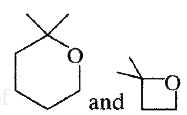Give four important reactions of benzene and explain the mechanism of any one of these reactions.
Step-by-Step Solution
Step 1: Identify Four Important Reactions of Benzene
1. Friedel-Crafts Alkylation: This reaction involves the introduction of an alkyl group into the benzene ring using an alkyl halide and a Lewis acid catalyst (like AlCl3).
2. Nitration: In this reaction, benzene reacts with a mixture of concentrated nitric acid (HNO3) and concentrated sulfuric acid (H2SO4) to introduce a nitro group (NO2) into the benzene ring.
3. Sulfonation: This reaction involves the introduction of a sulfonyl group (SO3H) into the benzene ring by treating benzene with fuming sulfuric acid (H2SO4 + SO3).
4. Halogenation: In this reaction, benzene reacts with halogens (like Br2) in the presence of a Lewis acid catalyst (like AlCl3) to introduce a halogen atom into the benzene ring.
---
Step 2: Explain the Mechanism of Friedel-Crafts Alkylation
1. Formation of the Electrophile:
- Benzene (C6H6) is treated with an alkyl halide (e.g., methyl chloride, CH3Cl) in the presence of a Lewis acid catalyst (AlCl3).
- The Lewis acid (AlCl3) interacts with the alkyl halide, causing the chlorine atom to leave and forming a carbocation (CH3+).
- The AlCl3 forms a complex with the chloride ion (Cl-), which enhances the positive charge on the carbocation.
2. Electrophilic Attack:
- The benzene ring, which has delocalized π electrons, acts as a nucleophile and attacks the positively charged carbocation (CH3+).
- This results in the formation of a cyclohexadienyl cation (C6H5-CH3+), where one hydrogen atom is temporarily removed from the benzene ring.
3. Deprotonation:
- To restore the aromaticity of the benzene ring, a proton (H+) is removed from the cyclohexadienyl cation.
- The AlCl4- ion (formed in the previous step) abstracts this proton, regenerating the AlCl3 catalyst and forming the final product, toluene (C6H5-CH3).
4. Overall Reaction:
- The overall reaction can be summarized as:
C6H6+CH3ClAlCl3−−−→C6H5CH3+HCl
---
2. Nitration: In this reaction, benzene reacts with a mixture of concentrated nitric acid (HNO3) and concentrated sulfuric acid (H2SO4) to introduce a nitro group (NO2) into the benzene ring.
- Benzene (C6H6) is treated with an alkyl halide (e.g., methyl chloride, CH3Cl) in the presence of a Lewis acid catalyst (AlCl3).
- The Lewis acid (AlCl3) interacts with the alkyl halide, causing the chlorine atom to leave and forming a carbocation (CH3+).
- The AlCl3 forms a complex with the chloride ion (Cl-), which enhances the positive charge on the carbocation.
- The benzene ring, which has delocalized π electrons, acts as a nucleophile and attacks the positively charged carbocation (CH3+).
- This results in the formation of a cyclohexadienyl cation (C6H5-CH3+), where one hydrogen atom is temporarily removed from the benzene ring.
- To restore the aromaticity of the benzene ring, a proton (H+) is removed from the cyclohexadienyl cation.
- The AlCl4- ion (formed in the previous step) abstracts this proton, regenerating the AlCl3 catalyst and forming the final product, toluene (C6H5-CH3).
- The overall reaction can be summarized as:
C6H6+CH3ClAlCl3−−−→C6H5CH3+HCl
Topper's Solved these Questions
- HYDROCARBONSBOOK - MODERN PUBLICATIONCHAPTER - HYDROCARBONSEXERCISE - Revision Exercises (Long Answer Questions (Carrying 5 marks))
4 Videos
- HYDROCARBONSBOOK - MODERN PUBLICATIONCHAPTER - HYDROCARBONSEXERCISE - HOTS (HIGHER ORDER THINKING SKILLS)
15 Videos
- HYDROCARBONSBOOK - MODERN PUBLICATIONCHAPTER - HYDROCARBONSEXERCISE - Revision Exercises (Very Short Answer Questions)
32 Videos
- HALOALKANES AND HALOARENESBOOK - MODERN PUBLICATIONCHAPTER - HALOALKANES AND HALOARENESEXERCISE - UNIT PRACTICE TEST
12 Videos
- HYDROGENBOOK - MODERN PUBLICATIONCHAPTER - HYDROGENEXERCISE - UNIT PRACTICE TEST (for Board Examination)
9 Videos
Similar Questions
Explain the mechanism of nitration of benzene.
View SolutionExplain the mechanism of the following reaction:

View SolutionReaction Mechanism
View SolutionReaction Mechanism
View SolutionReaction Mechanism
View SolutionGive the mechanisms of the reaction

View SolutionGive the mechanisms of the reaction

View Solution_E01_072_Q01.png)
Give mechanism of this reaction.
View SolutionConsider the reaction of
 with aqueous HI.
with aqueous HI.
Give the mechanism and product of the faster reaction
View SolutionExplain the mechanism of SN2 reaction.
View Solution
